- Home
- Carl Sagan
Dragons of Eden Page 13
Dragons of Eden Read online
Page 13
Statistical studies have been made of the most common categories of dreams—studies which, at least to some extent, ought to illuminate the nature of dreams. In a survey of the dreams of college students, the following were, in order, the five most frequent types: (1) falling; (2) being pursued or attacked; (3) attempting repeatedly and unsuccessfully to perform a task; (4) various academic learning experiences; and (5) diverse sexual experiences. Number (4) on this list seems of special and particular concern to the group being sampled. The others, while sometimes actually encountered in the lives of undergraduates, are likely to be applicable generally, even to non-students.
The fear of falling seems clearly connected with our arboreal origins and is a fear we apparently share with other primates. If you live in a tree, the easiest way to die is simply to forget the danger of falling. The other three categories of most common dreams are particularly interesting because they correspond to aggressive, hierarchical, ritualistic and sexual functions—the realm of the R-complex. Another provocative statistic is that almost half of the people queried reported dreams about snakes, the only nonhuman animal rating a category all to itself in the twenty most common dreams. It is, of course, possible that many snake dreams have a straightforward Freudian interpretation. However, two-thirds of the respondents reported explicitly sexual dreams. Since, according to Washburn, young primates exhibit an untaught fear of snakes, it is easy to wonder whether the dream world does not point directly as well as indirectly to the ancient hostility between reptiles and mammals.
There is one hypothesis that seems to me consistent with all the foregoing facts: The evolution of the limbic system involved a radically new way of viewing the world. The survival of the early mammals depended on intelligence, daytime unobtrusiveness, and devotion to the young. The world as perceived through the R-complex was quite a different world. Because of the accretionary nature of the evolution of the brain, R-complex functions could be utilized or partially bypassed but not ignored. Thus, an inhibition center developed below what in humans is the temporal lobe, to turn off much of the functioning of the reptilian brain; and an activation center evolved in the pons to turn on the R-complex, but harmlessly, during sleep. This view, of course, has some notable points of similarity to Freud’s picture of the repression of the id by the superego (or of the unconscious by the conscious), with expressions of the id made most clearly manifest in slips of the tongue, free associations, dreams and the like—that is, during the interstices of superego repression.
With the large-scale development of the neocortex in higher mammals and primates, some neocortical involvement in the dream state developed—a symbolic language is, after all, still a language. (This is related to the different functions of the two hemispheres of the neocortex, described in the following chapter.) But the dream imagery contained significant sexual, aggressive, hierarchical and ritualistic elements. The fantastic material in the dream world may be connected with the near-absence of direct sensory stimulation during dreams. There is very little reality testing in the dream state. The prevalence of dreams in infants would, in this view, be because, in infancy, the analytic part of the neocortex is barely working. The absence of dreams in reptiles would be because there is no repression of the dream state in reptiles; they are, as Aeschylus described our ancestors, “dreaming” in their waking state. I believe this idea can explain the strangeness—that is, the differences from our waking verbal consciousness—of the dream state; its mammalian and human neonatal localization; its physiology; and its pervasiveness in man.
We are descended from reptiles and mammals both. In the daytime repression of the R-complex and in the nighttime stirring of the dream dragons, we may each of us be replaying the hundred-million-year-old warfare between the reptiles and the mammals. Only the times of day of the vampiric hunt have been reversed.
Human beings exhibit enough reptilian behavior as it is. If we gave full rein to the reptilian aspects of our nature, we would clearly have a low survival potential. Because the R-complex is woven so intimately into the fabric of the brain, its functions cannot be entirely avoided for long. Perhaps the dream state permits, in our fantasy and its reality, the R-complex to function regularly, as if it were still in control.
If this is true, I wonder, after Aeschylus, if the waking state of other mammals is very much like the dream state of humans—where we can recognize signs, such as the feeling of running water and the smell of honeysuckle, but have an extremely limited repertoire of symbols such as words; where we encounter vivid sensory and emotional images and active intuitive understanding, but very little rational analysis; where we are unable to perform tasks requiring extensive concentration; where we experience short attention spans and frequent distractions and, most of all, a very feeble sense of individuality or self, which gives way to a pervading fatalism, a sense of unpredictable buffeting by uncontrollable events. If this is where we have come from, we have come very far.
* The electroencephalograph (EEG) was invented by a German psychologist, Hans Berger, whose fundamental interest in the matter seems to have been telepathy. And, indeed, it can be used for a kind of radio telepathy; human beings have the capability to turn particular brain waves—for example, the alpha rhythm—on and off at will, although this feat requires a little training. With such training, an individual attached to an electroencephalograph and a radio transmitter could, in principle, send quite complex messages in a kind of alpha wave Morse code, merely by thinking them in the right way; and it is just possible that this method might have some practical use, such as permitting patients immobilized by severe stroke to communicate. For historical reasons, non-dreaming sleep is electroencephalographically characterized as “slow wave sleep,” and the dream state as “paradoxical sleep.”
* Robert Bakker, a paleontologist at Harvard University, suggests that at least some dinosaurs were significantly warm-blooded; even, so, it seems likely that they were not as insensitive to diurnal temperature change as mammals are, and that they slowed down substantially at night.
* In fact, the birds are almost certainly the principal living descendants of the dinosaurs.
* It is in the Greater Sunda Islands—more specifically Java—that the first specimen of Homo erectus, with an endocranial volume of almost 1,000 cc, was found by E. Dubois in 1891.
† Curiously, the first representative skull of Peking man—the Homo erectus whose remains are clearly associated with the use of fire—was discovered by Weng Chung Pei late in 1929 in Sinkiang Province, China, in a place called the Mountain of Dragons.
* Since writing this passage I have discovered that Darwin expressed a similar thought: “May we not suspect that the vague but very real fears of children, which are quite independent of experience, are inherited effects of real dangers and abject superstitions during ancient savage times? It is quite conformable with what we know of the transmission of formerly well-developed characters, that they should appear at an early period of life, and afterwards disappear”—like gill slits in human embryology.
7
LOVERS
AND
MADMEN
Lovers and madmen have such seething brains
Such shaping fantasies, that apprehend
More than cool reason ever comprehends.
The lunatic, the lover, and the poet
Are of imagination all compact …
WM. SHAKESPEARE
A Midsummer Night’s Dream
Mere poets are as sottish as mere drunkards are, who live in a continual mist, without seeing or judging anything clearly. A man should be learned in several sciences, and should have a reasonable, philosophical, and in some measure a mathematical head, to be a complete and excellent poet …
JOHN DRYDEN
“Notes and Observations on
The Empress of Morocco,” 1674
LOODHOUNDS have a widely celebrated ability to track by smell. They are presented with a “trace”—a scrap of clothing belonging to t
he target, the lost child or the escaped convict—and then, barking, bound joyously and accurately down the trail. Canines and many other hunting animals have such an ability in extremely well-developed form. The original trace contains an olfactory cue, a smell. A smell is merely the perception of a particular variety of molecule—in this case, an organic molecule. For the bloodhound to track, it must be able to sense the difference in smell—in characteristic body molecules—between the target and a bewildering and noisy background of other molecules, some from other humans who have gone the same way (including those organizing the tracking expedition) and some from other animals (including the dog itself). The number of molecules shed by a human being while walking is relatively small. Yet even on a fairly “cold” trail—say, several hours after the disappearance—bloodhounds can track successfully.
This remarkable ability involves extremely sensitive olfactory detection, a function, as we saw earlier, performed well even by insects. But what is most striking about the bloodhound and different from insects is the richness of its discriminative ability, its aptitude in distinguishing among many different smells, each in an immense background of other odors. The bloodhound performs a sophisticated cataloging of molecular structure; it distinguishes the new molecule from a very large library of other molecules previously smelled. What is more, the bloodhound needs only a minute or less to familiarize itself to the smell, which it can then remember for extensive periods of time.
The olfactory recognition of individual molecules is apparently accomplished by individual nasal receptors sensitive to particular functional groups, or parts, of organic molecules. One receptor, for example, may be sensitive to COOH, another to NH2, and so on. (C stands for carbon, H for hydrogen, O for oxygen and N for nitrogen.) The various appurtenances and projections of the complex molecules apparently adhere to different molecular receptors in the nasal mucosa, and the detectors for all the functional groups combine to put together a kind of collective olfactory image of the molecule. This is an extremely sophisticated sensor} system. The most elaborate man-made device of this sort, the gas Chromatograph/mass spectrometer, has in general neither the sensitivity nor the discriminative ability of the bloodhound, although substantial progress is being made in this technology. The olfactory system of animals has evolved into its present sophistication because of strong selection pressures. Early detection of mates, predators and prey is a matter of life and death for the species. The sense of smell is very ancient, and indeed, much of the early evolution above the level of the neural chassis may have been spurred by selection pressure for such molecular detection: the distinctive olfactory bulbs in the brain (see figure on this page) are among the first components of the neocortex to have deveoped in the history of life. Indeed, the limbic system was called the “rhinencephalon,” the smell-brain, by Herrick.
The sense of smell is not nearly so well developed in humans as in bloodhounds. Despite the massive-ness of our brains, our olfactory bulbs are smaller than those of many other animals, and it is clear that smell plays a very minor role in our everyday lives. The average person is able to distinguish relatively few smells. Our verbal descriptions and analytic comprehension of smell, even with only a few odors in our repertoire, is extremely poor. Our response to an odor hardly resembles, in our own perception, the actual three-dimensional structure of the molecule responsible for the smell. Olfaction is a complex cognitive task which we can, within limits, perform—and with considerable accuracy—but which we can describe inadequately at best. And if the bloodhound could speak, I think it would be at a similar loss to describe the details of what it does so supremely well.
Just as smell is the principal means by which dogs and many other animals perceive their surroundings, sight is the primary information channel in humans. We are capable of visual sensitivity and discrimination at least as impressive as the olfactory abilities of the bloodhound. For example, we are able to discriminate among faces. Careful observers can distinguish among tens or even hundreds of thousands of different faces; and the “Identikit,” widely used by Interpol and by police forces in the West generally, is capable of reconstructing more than ten billion different faces. The survival value of such an ability, particularly for our ancestors, is quite clear. Yet consider how incapable we are of describing verbally faces that we are perfectly capable of recognizing. Witnesses commonly exhibit a total failure in verbal description of an individual previously encountered, but high accuracy in recognizing the same individual when seen again. And while cases of mistaken identity have certainly occurred, courts of law seem willing to admit the testimony of any adult witness on questions of facial recognition. Consider how easily we can pick, from a vast crowd of faces, a “celebrity”; or how in a dense non-ordered list our own name leaps out at us.
Human beings and other animals have very sophisticated high-data-rate perceptual and cognitive abilities that simply bypass the verbal and analytic consciousness that so many of us regard as all of us there is. This other kind of knowing, our nonverbal perceptions and cognitions, is often described as “intuitive.” The word does not mean “innate.” No one is born with a repertoire of faces implanted in his brain. The word conveys, I think, a diffuse annoyance at our inability to understand how we come by such knowledge. But intuitive knowledge has an extremely long evolutionary history; if we consider the information contained in the genetic material, it goes back to the origin of life. The other of our two modes of knowing—the one that in the West expresses irritation about the existence of intuitive knowledge—is a quite recent evolutionary accretion. Rational thinking that is fully verbal (involving complete sentences, say) is probably only tens or hundreds of thousands of years old. There are many people who are, in their conscious lives, almost entirely rational, and many who are almost entirely intuitive. Each group, with very little appreciation of the reciprocal value of these two kinds of cognitive ability, derides the other: “muddled” and “amoral” are typical adjectives used in the more polite of such exchanges. Why should we have two different, accurate and complementary modes of thinking which are so poorly integrated with each other?
The first evidence that these two modes of thinking are localized in the cerebral cortex has come from the study of brain lesions. Accidents or strokes in the temporal or parietal lobes of the left hemisphere of the neocortex characteristically result in impairment of the ability to read, write, speak and do arithmetic. Comparable lesions in the right hemisphere lead to impairment of three-dimensional vision, pattern recognition, musical ability and holistic reasoning. Facial recognition resides preferentially in the right hemisphere, and those who “never forget a face” are performing pattern recognition on the right side. Injuries to the right parietal lobe, in fact, sometimes results in the inability of a patient to recognize his own face in a mirror or photograph. Such observations strongly suggest that those functions we describe as “rational” live mainly in the left hemisphere, and those we consider “intuitive,” mainly in the right.
The most significant recent experiments along these lines have been performed by Roger Sperry and his collaborators at the California Institute of Technology. In an attempt to treat severe cases of grand mal epilepsy, here patients suffer from virtually continuous seizures (as frequent as twice an hour, forever), they cut the corpus callosum, the main bundle of neural fibers connecting the left and right hemispheres of the neocortex (see the figure on this page). The operation was an effort to prevent a kind of neuroelectrical storm in one hemisphere from propagating, far from its focus, into the other. The hope was that at least one of the two postoperative hemispheres would be unaffected by subsequent seizures. The unexpected and welcome result was that the frequency and intensity of the seizures declined dramatically in both hemispheres—as if there had previously been a positive feedback, with the epileptic electrical activity in each hemisphere stimulating the other through the corpus callosum.
A top view of the human brain, in which the two cerebral hemis
pheres have been separated by neurosurgeons in a successful attempt to control epileptic seizures. The separation is accomplished principally by cutting the corpus callosum. The more minor connectors of the two hemispheres, the anterior commissure and the hippocampal commissure, are also sometimes cut.
Copyright © 1967 by Scientific American
Such “split-brain” patients appear, superficially, entirely normal after the surgery. Some report a complete cessation of the vivid dreams they experienced before the operation. The first such patient was unable to speak for a month after the operation, but his aphasia later disappeared. The normal behavior and appearance of split-brain patients in itself suggests that the function of the corpus callosum is subtle. Here is a bundle of two hundred million neural fibers processing something like several billion bits per second between the two cerebral hemispheres. It contains about 2 percent of the total number of neurons in the neocortex. And yet when it is cut, nothing seems to change. I think it is obvious that there must in fact be significant changes, but ones that require a deeper scrutiny.

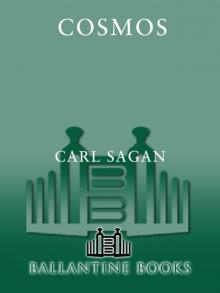 Cosmos
Cosmos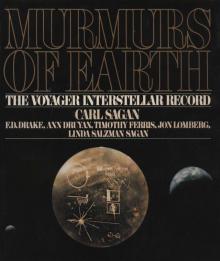 Murmurs of Earth
Murmurs of Earth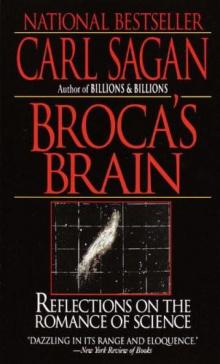 Broca's Brain
Broca's Brain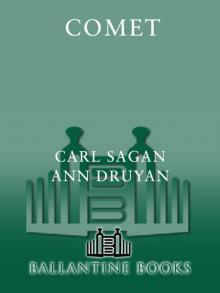 Comet
Comet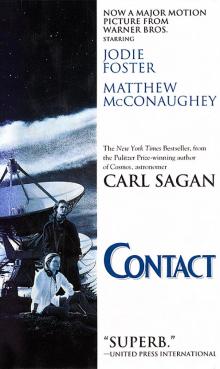 Contact
Contact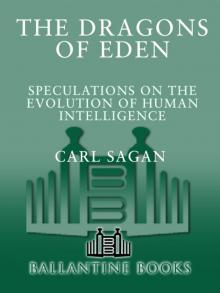 Dragons of Eden
Dragons of Eden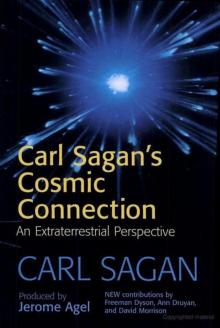 Cosmic Connection
Cosmic Connection Shadows of Forgotten Ancestors
Shadows of Forgotten Ancestors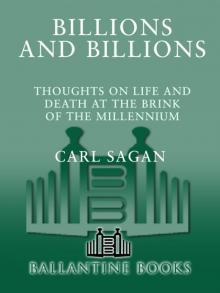 Billions & Billions
Billions & Billions Comet, Revised
Comet, Revised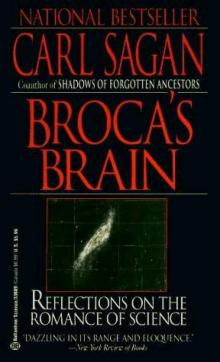 Broca's Brain: The Romance of Science
Broca's Brain: The Romance of Science The Varieties of Scientific Experience: A Personal View of the Search for God
The Varieties of Scientific Experience: A Personal View of the Search for God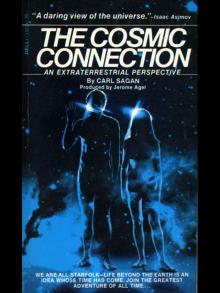 The Cosmic Connection
The Cosmic Connection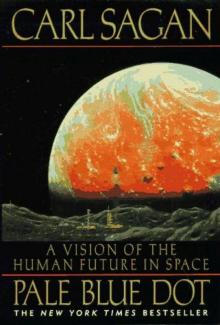 Pale Blue Dot: A Vision of the Human Future in Space
Pale Blue Dot: A Vision of the Human Future in Space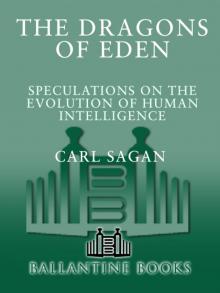 The Dragons of Eden
The Dragons of Eden